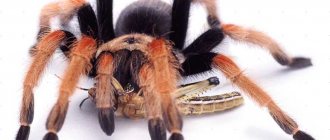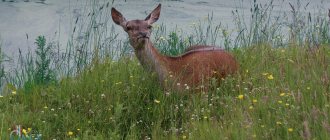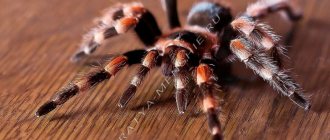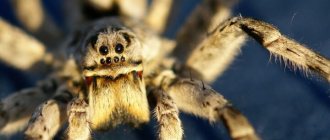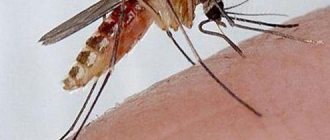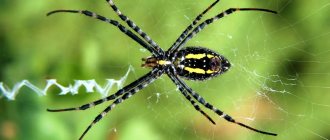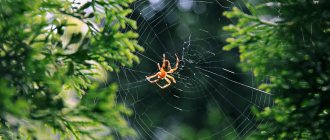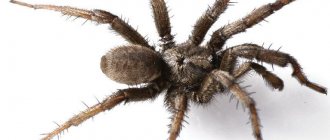“Tarantulas will never attack a person first.” Hairy spiders are increasingly seen in Belarus
Hairy spiders are increasingly seen in Belarus
Photo: Victor GILITSKY
Poisonous tarantula spiders recently reminded of themselves: their invasion is noted in one of the southernmost regions of Belarus - Lelchitsky. According to local residents, hairy spiders are spotted not only on the street, in vegetable gardens, but also in houses and administrative buildings. And just the other day a tarantula was seen in the more northern regional center of the Gomel region - Rechitsa. There, a spider scared the residents of an apartment building by climbing to the fifth floor.
Many people don’t know what to do with a tarantula—is it dangerous, how to protect themselves from arthropods...
In general, the first poisonous spiders were noticed in the south of Belarus 5-6 years ago, when the climate became warmer and more suitable for southern Russian tarantulas, praying mantises and other insects common in more southern latitudes. It was from there, from Ukraine, that the uninvited guests came to Belarus.
However, in the southern neighboring country they have long been accustomed to tarantulas and are not afraid of them. Shaggy arthropods are familiar here, and therefore are perceived as one of our own, dear, and harmless. Children even play with them, specialists from the biology department of Gomel State University named after Skorina told Komsomolskaya Pravda.
— Tarantulas usually sit in holes and wait for something edible. They do not weave webs, waiting for random prey, but actively hunt themselves, and at night. They run out of holes when they feel a vibration or when a shadow flashes by. In general, these spiders are shy and short-sighted. But they can crawl along vertical walls, so it’s not surprising that they were seen on the fifth floor,” says Nikolai Galinovsky, Candidate of Biological Sciences, Associate Professor.
He calls not to be afraid of tarantulas and not to kill them, because a spider will never be the first to attack a person. After all, the arthropod does not perceive it as a food object:
“You have to try really hard for a tarantula to bite a person.” For example, teasing, sticking fingers into a hole. And the spider feeds on insects, including cockroaches. It can attack its smaller brothers, and even small lizards.
Belarusians are afraid of tarantulas, because the type of spider is not yet familiar to us, the scientist notes. You should not be afraid of an insect, even if it stands on its hind legs - at the same time, it itself is afraid, feels some kind of threat, so it wants to scare the enemy with its appearance.
There is nothing strange in the fact that tarantulas come to people. After all, in houses, entrances, and basements there is a lot of food for them: flies, cockroaches, crickets, for example.
In general, if you notice a tarantula in your house or yard, you should, firstly, not be afraid, but also not touch the spider with your hands. In the house, the tarantula can be driven into a jar with a broom and taken outside. And in the yard, find a hole and destroy it with a shovel so that the spider goes to another place.
For a healthy person, a tarantula bite is painful, but not dangerous - just like from bees, for example. Only those people who are prone to allergic reactions should stay away from tarantulas. If such people are bitten by a spider, sudden shortness of breath, swelling of the face, tongue, and rash may appear - just like with a flying insect bite. In such cases, you should immediately call an ambulance and take anti-allergy medications.
Unusual tourists
One of the latest sensational discoveries was evidence of the existence of the golden jackal on the territory of Belarus. According to Vadim PROKOPCHUK , an employee of the scientific department the Belovezhskaya Pushcha National Park , this animal has joined the official list of mammals of Belarus. A rare species for our region was caught during a hunt on December 9, 2022 in the Kobrin region. During a detailed DNA analysis, specialists from the scientific and practical center of the State Committee for Forensic Expertise confirmed that the tissue samples belonged to an adult male golden jackal.
Why the jackal moves north is not known exactly. According to Doctor of Biological Sciences , Professor of the Faculty of Biology of BSU Vasily GRICHIK , the reason for this may be global warming and winters with little snow.
Another reason for discussion among scientists was the appearance of a forest cat in the Narovlya region, which had not been seen in Belarus since the 1930s. It was possible to photograph the animal on June 22, 2022 using a camera trap, which was placed in the former settlement of Rojava in the exclusion zone.
Senior researcher at the Laboratory of Molecular Zoology of Center of the National of Belarus for Bioresources , Valery DOMBROVSKY , after a detailed study of the photo, expressed the opinion that the photo could indeed be a forest cat. But the head of the laboratory of molecular zoology of the Scientific and Practical Center for Bioresources of the National Academy of of Belarus Mikhail NIKIFOROV , is convinced that one photograph is not enough as proof that the forest cat has returned to us.
Reach Alaska. Why did the USSR want to block the Bering Strait? More details
What does a tarantula look like?
In the photo, the tarantula strongly resembles a tarantula spider, but the latter is a mygalomorphic spider and is particularly large in size.
Tarantula.
Tarantulas are quite large spiders, growing up to 10 cm in length with a body weight of about 90 g. The size of the legendary Apulian tarantulas usually does not exceed 7 cm, southern Russian relatives are much smaller and grow up to 2.5 - 3.5 cm. Females of any species are larger than males .
Tarantula.
The fluffy body of the tarantula is formed by two sections: the cephalothorax and abdomen, connected by a thin hollow bridge - a stalk. The upper part of the body is covered with a dense chitinous shell, the stomach remains defenseless. There are 4 pairs of eyes on the head, allowing one to see the blurry outlines of prey at a distance of 20–30 cm.
The long legs of predators are densely studded with sensitive hairs, which play an important tactile role in searching for prey and protect the spider from natural enemies. When in contact with human skin, the hairs can cause an allergic reaction.
South Russian tarantula or Mizgir: close-up view of the muzzle.
The protective coloration allows tarantulas to successfully camouflage themselves against the background of the surrounding landscape. Apulian tarantulas are painted in dark colors with a light edging; the abdomen of females is red, decorated with one longitudinal and several transverse black and white stripes. You can recognize the South Russian tarantula in the photo by its black belly and brown-red top.
Dzungarian tarantula
The South Russian or Dzungarian tarantula is common in the Caucasus, Central Asia, and southern Ukraine. Here it can be found in the steppes, in floodplain meadows near rivers.
When viewed from the front, the Dzungarian tarantula is quite cute and resembles a fairy-tale gnome. In a calm state, its front legs are lowered and a large streamlined head part of the body is visible, below is a transverse strip of short hairs, reminiscent of a short whisker brush; under it there is thick, longer hair, similar to a goatee, and above there are 2 large and under them 4 smaller eyes
Just a cartoon character! But if suddenly someone had the imprudence to disturb it, the picture changes radically: the spider raises its front legs high above its head, taking a threatening pose. Now he no longer looks like the sweetest creature
He's ready to attack!
The tarantula's vision is excellent. The spider has 8 eyes located at the cephalothorax end. 4 of them are shiny and clearly visible, and 4 are duller. The spider's 8 large legs, widely spaced in all directions, are covered with long black hairs. The poisonous apparatus of the tarantula is located on the sides of the anterior section of the cephalothorax and consists of two glands, the ducts of which end at the sharp ends of the strong jaws.
Winged guests
As experts from the NGO “Akhova Ptushak Batskaushchyny” note, every year more and more rare birds fly to Belarus. For example, in 2017, a discovery for Belarusian ornithologists was the Lapland plantain, which in 100 years has been documented only once in our country, and last winter experts met a record number of birds of this species in the entire history of ornithology.
In addition, according to birdwatch.by, the list of bird species in Belarus at the beginning of 2022 contains 329 names. Since 2000, it has included about 20 new species, as well as about 5 species that were recorded nesting for the first time.
Also among the unusual trends of recent years are cases of bats wintering in Belarus. Now, in order to protect the population of this animal, a shelter is being organized in the wildlife corner of the Republican Center for Ecology and Local History. Here the mice will spend the winter in the refrigerator. “Bats hibernate when the air temperature is below zero. But, since the winters are now warm, these animals are active until the New Year, which negatively affects their life. Without a sufficient supply of energy, these animals die in just a couple of days,” said Aleksey a researcher at the Laboratory of Molecular Zoology National Academy of Sciences Research Center for Bioresources .
The climate is just right. There are more rainfalls and droughts, but there have always been tornadoes Read more
Description of the tarantula
The tarantula is part of the wolf spider family, although they are constantly trying to mate it with tarantula spiders (lat. theraphosidae). Tarantulas differ from the latter in the direction of movement of the jaws.
Chelicerae (due to poisonous ducts on their jagged tops) perform two functions - an oral appendage and an attack/defense weapon.
The most attractive thing about the tarantula’s appearance is its 3 rows of shiny eyes: the first (bottom) row consists of four tiny “beads”, 2 larger eyes are “mounted” on top of them, and, finally, another pair is placed on the sides.
Eight spider “eyepieces” vigilantly monitor what is happening, distinguishing light and shadow, as well as the silhouettes of familiar insects at an interval of up to 30 cm. The spider boasts excellent hearing - it can hear human steps 15 km away.
The tarantula grows, depending on the variety, up to 2.5 – 10 cm (with a limb span of 30 centimeters).
Females are larger than their partners, often gaining a record weight of 90 grams.
The color of the spider can vary and depends on its habitat. Thus, the South Russian tarantula usually displays a brown, slightly reddish or sandy-gray color with black spots.
A series of changes
Over the past thirty years, average annual temperatures in Belarus have increased by 1.3 degrees. Experts say the climate is changing. And that's a fact. The natural conditions in which we are accustomed to living are also changing. And now everyone can feel this for themselves.
Despite the abundance of observations and research, people are still faced with climate mysteries. Therefore you need to be on your guard. It is possible that at some point you will discover a new species of animal.
Adam GRINEWSKI
Keeping the South Russian tarantula at home
The ability to control oneself, attentiveness, and caution are required from those who decide to have a Mizgir as a pet.
These spiders are very interesting to watch, they are funny, smart, so there are many people who are fascinated by them. A terrarium or an aquarium with a lid can become a home for a misgir. Ventilation is required. The minimum dimensions of the arachnarium are calculated taking into account the paw span of the future resident - the length and width should be 3 times greater. The spider can jump 20 cm in height, so this must be taken into account.
The bottom of the arachnarium is covered with soil: sand, turf, coconut fiber, vermiculite or peat. The height of the layer must be at least 30 cm so that the mizgir can make a full-fledged burrow.
Mizgir from the side
The pet will love to sunbathe on a piece of driftwood under a lamp; a small number of plants and constant moistening of the substrate are also useful. He can bathe in the installed drinking bowl. Feeding is not difficult - flies, ground beetles, crickets, cockroaches, mosquitoes, etc. are sold in pet stores, but you can catch them yourself.
Cleaning is carried out once every 2 months by luring the spider out with food or a small ball on a string and transplanting it into another container. In winter, the spider can hibernate, sealing the entrance to the hole, or simply become less active if the temperature has not changed and remains at 20-30 degrees. Tarantulas are considered one of the most interesting objects to observe, but children should not have them
Despite its size, a spider cannot be called a toy; any careless movement can cause aggression. The shaggy handsome man will bring many pleasant moments to teenagers and adults, entertaining them with hunting and home improvement.
Video
https://youtube.com/watch?v=GXeiyy88bkY
Sources
- https://beetlestop.ru/yuzhnorusskiy-tarantul/https://www.zoopicture.ru/yuzhnorusskij-tarantul/https://pets2.me/bok/1803-yuzhnorusskiy-tarantul-kak-vyglyadit-gde-obitaet- chem-kormit-v-domashnih-usloviyah.htmlhttps://ukusili.net/chto-delat-pri-ukuse-tarantula/https://simple-fauna.ru/spiders/yuzhnorusskij-tarantul-ili-mizgir/https: //ru.wikipedia.org/wiki/South Russian_tarantulahttps://apest.ru/pauki/vidy-paukov/pauk-mizgir/
Biological certificate
Now let's move on to a description of the tarantula, the characteristics of its behavior, nutrition and reproduction, and give it a brief description as a representative of the animal world.
Scientific classification and lifestyle
The genus of tarantulas belongs to the wolf spider family. They live mainly in burrows, in which they spend all daylight hours, and at night they go out hunting. These arthropods also weave a web, but they use it not as a trapping net, but as a decoration for the walls of their underground apartments and for arranging an oviposition cocoon.
Tarantulas are often confused with tarantula spiders, which is greatly facilitated by the fact that in some languages the word “tarantula” is used to refer to representatives of this family, and even if we ignore the differences in size, these arthropods are similar to each other.
The main difference between the two families is the structure and functioning of the chylicerae. In wolves they move towards each other, in tarantulas they move in parallel.
Description
What does a tarantula look like? These are quite large spiders, reaching a leg span of 30 centimeters. Males are always slightly smaller than females. The bodies of spiders are covered with hairs of gray, brown or brown color, depending on the species.
The largest sizes are tarantulas representing South America; their European relatives rarely exceed a body length of five centimeters.
An interesting question is about the organs of vision of representatives of this family. Curious lovers of the animal world are often interested in how many eyes a tarantula has. We answer - he has eight of them, which allows you to view the entire panorama around both horizontally and vertically.
Nutrition
It is also important to know what tarantulas eat. This is especially true for those lovers of arthropods who are going to breed them in their own apartment
And what, as the character in “The Twelve Chairs” said: “Who cares for a mare!”
So, the night hunter feeds on everything that is shorter. It could be an insect, an arachnid of another species, or even small mammals and birds. Digestion in tarantulas, like many other spiders, is external. First, the predator introduces poison and digestive juices into the body of the victim, which decompose the tissues of the victim, and only then absorbs the digested substrate.
Spreading
The question of where tarantulas are found is the most popular among arachnophobes, people who are afraid of spiders. In this regard, residents of central Russia and regions with similar or more severe climatic conditions can rest easy. Here the tarantula can only be found in various zoos and apartments of enthusiasts and Spider-Man fans.
But in the south of our country, our neighboring states, the south of Europe, the African, Asian and American continents, tarantulas are found in large numbers.
Reproduction
Tarantula spiders reproduce like representatives of other spider families, but they still have their own characteristics. First of all, this is the famous mating dance, by which the spider recognizes the male of its own species. In general, the mating process can be divided into the following stages:
- At the end of summer, the male decides that it is time to extend his tarantula lineage and goes in search of a female.
- Having found the intended bride, he begins to perform a ritual dance.
- She, in turn, takes a closer look at the gentleman, and if she decides that he is the man of her dreams and belongs to the same species, she begins to respond to him, copying the dance steps.
- After such identification, mating itself occurs, after which the groom hurries to quickly retreat before the missus decides to eat him. It must be said that in this respect, male tarantulas are more agile than representatives of the male population of other spiders.
Next, the female finds a burrow suitable for wintering, where she spends the entire winter. With the onset of spring, she crawls out of her home and exposes her abdomen to the warm rays of the young sun.
In the female’s body, warmed by the warmth of the sun, eggs begin to form, up to 700 eggs depending on the species. At the end of this process, the female weaves a cocoon from the web directly on her stomach, where she places the formed eggs.
So she carries her offspring on herself until the young begin to hatch. Sensing this moment, the young mother gnaws through the cocoon and releases her children into the wild.
However, the babies do not leave their mother, but move onto her back, where she carries them until they learn to feed themselves.
Why is a tarantula dangerous?
As mentioned earlier, the bite of a tarantula, no matter what species it belongs to, is still poisonous. How dangerous a tarantula is depends on the age of the predator, race, gender, season and some other factors.
Let's consider the toxicity of these insects, based on the time of year:
- April
- just waking up after winter, tarantulas are very inert, their poison is not too toxic. - May
- in the middle of this month there comes a period when females lay eggs. Spiders become very active, and the toxicity of the poison increases by 2 times. - June
- mating and migration occur at the beginning of the month; the venom of predators at this time is 3 times more toxic. - August
- spiders, especially young females, have less toxic venom. - September
- before wintering, the toxicity of the venom of hairy insects is reduced by 2 times.
Why is the tarantula spider dangerous for living beings? It is not for nothing that this creature is considered a predator; its bite has a neurogenic effect on the nervous system. The venom of this spider can lead to neuromuscular disorders, disorders of the respiratory and cardiovascular systems
So you need to be extremely careful with this cute and fluffy creature of nature.
